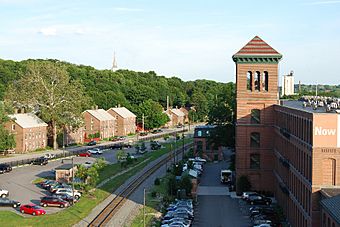Ashton Historic District facts for kids
Quick facts for kids |
|
|
Ashton Historic District
|
|
 |
|
| Lua error in Module:Location_map at line 420: attempt to index field 'wikibase' (a nil value). | |
| Location | Cumberland, Rhode Island |
|---|---|
| Area | 61 acres (25 ha) |
| NRHP reference No. | 84000367 |
| Added to NRHP | November 1, 1984 |
The Ashton Historic District is a special area in Cumberland, Rhode Island. It's called a historic district because it has old buildings that are important to history. This district includes a large mill and a village built right next to it. The village was home to the people who worked in the mill. You can find this district near Mendon Road, Scott Road, and other streets. It was added to the National Register of Historic Places on November 1, 1984. This means it's officially recognized as a place worth preserving.
Contents
What is the Ashton Historic District?
The Ashton Historic District is a unique place in Cumberland, Rhode Island. It covers about 61 acres (25 hectares). This area is special because it shows how people lived and worked long ago. It includes a big factory, called a mill, and a small town built just for the mill workers.
The Mill and Its Village
The district is located along the Blackstone River. It sits between several roads like Mendon Road and Store Hill Road. The mill and its village are important examples of how factories and towns grew together. They show a key part of American history.
History of the Ashton Mill
The mill in Ashton was built by the Lonsdale Company. This company was growing quickly in the 1800s. They decided to build a new mill in Ashton in 1867. It was placed on the east side of the Blackstone River.
Building the Mill
The mill was first built with three and a half stories. It had a special roof called a mansard roof. Later, the mill was made even bigger. Workers added another half-story, making it four full stories tall. The roof was also changed to a flat roof.
A Place for New Ideas
This mill was very important for new technology. It was one of the first places to test a new machine part called the Sawyer spindle. This spindle helped make cloth much faster. It was one of the first high-speed spindles developed in the United States. This invention changed how textiles were made.
The Mill Village
Right next to the mill, a village was built for the workers. This village has many brick houses. These houses are called row houses because they are built in a line. There was also a nice office building with a mansard roof.
Village Life and Design
The houses in the Ashton mill village are simple but well-designed. They are packed closely together. This shows how many people lived and worked in the area. The village is located in a narrow, flat area. It sits at the bottom of a small hill. This hill carries Mendon Road, which is also Rhode Island Route 122.

